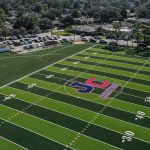Gildan Activewear Inc. reported a 56 percent drop in quarterly earnings, as net earnings were $26.9 million, or 22 cents per diluted share, for its second fiscal quarter ended April 1, compared with
net earnings of $61.7 million, or 50 cents per diluted share, in the second
quarter of fiscal 2011. Net sales in the second quarter were up 25.9
percent to $482.6 million from $383.2 million in the second quarter of fiscal 2011.
Second Quarter Results
Before restructuring and acquisition-related costs, adjusted net earnings for the second quarter of fiscal 2012 were $27.8 million, or 23 cents per share, compared to $64.6 million, or 53 cents per share, in the second quarter of last year. The company had previously projected net earnings of approximately 20 cents per share for the second quarter, when it reported its first quarter results on February 8.
The decline in the company's results compared to last year was due to significantly higher cotton costs, which negatively impacted EPS in the second quarter by close to 70 cents compared to the second quarter of last year. The impact of higher cotton and other input costs and higher income taxes compared to last year were partially offset by higher printwear sales volumes, the benefit of selling price increases to U.S. retail customers which were implemented in the fourth quarter of fiscal 2011, improved manufacturing efficiencies and the accretive impact of the acquisition of Gold Toe Moretz.
Net sales in the second quarter amounted to $482.6 million, up 25.9 percent from $383.2 million in the second quarter of fiscal 2011, and essentially in line with its forecast of close to $500 million. Sales for the Printwear segment amounted to $360.9 million, up 11.5 percent from fiscal 2011, and sales for the Branded Apparel segment were $121.6 million, up 104.2 percent from the second quarter of last year.
The increase in sales in the Printwear segment compared to the second quarter of fiscal 2011 was due to higher unit sales volumes, as U.S. distributors rebuilt inventories to more normal levels after destocking in the first quarter of the fiscal year in anticipation of the selling price decrease announced in December 2011. In addition, industry demand from U.S. screenprinters, as reported in the CREST report, increased by 4.9 percent compared to the second quarter of last year, and Gildan's market share in the U.S. distributor channel was 63 percent, compared to 62 percent in the second quarter of fiscal 2011. Shipments to national account customers were essentially unchanged from the second quarter of last year. International unit sales volumes in the Printwear business segment reflected strong growth compared to the second quarter of fiscal 2011.
The growth in sales for the Branded Apparel segment was due to the impact of the acquisition of Gold Toe Moretz, together with higher net selling prices, partially offset by the continuation of weaker retail market conditions and inventory destocking by retailers.
Consolidated gross margins in the second quarter were 17.8 percent compared to 28.4 percent last year. The decline in gross margins was due to the significant negative impact of higher cotton and other input costs, partially offset by favourable manufacturing efficiencies, and higher selling prices and favourable product-mix for Branded Apparel.
SG&A expenses in the second quarter were $53.9 million, compared with $47.3 million in the second quarter of last year. The increase in SG&A expenses was due to the acquisition of Gold Toe Moretz. Excluding the impact of Gold Toe Moretz, SG&A expenses declined due to lower variable compensation expenses, the non-recurrence of a prior year loss on the sale of fixed assets and SG&A expense reductions in Branded Apparel. SG&A expenses for the Branded Apparel segment reflect the sales, distribution and administrative infrastructure which has been put in place to support the long-term growth and development of the Branded Apparel business, as well as the duplication of certain overhead expenses subsequent to the acquisition of Gold Toe Moretz.
In the second quarter, the Printwear division reported operating income of $50.1 million, compared with $89.2 million in the second quarter of fiscal 2011. The decline in the results for the Printwear segment was due to the impact of higher cotton and other input costs, partially offset by higher unit sales volumes and manufacturing efficiencies. The Branded Apparel division reported operating income of $1.1 million, versus an operating loss of $5.9 million in the second quarter of fiscal 2011 as the negative impact of higher cotton and other input costs was more than offset by the accretion from the acquisition of Gold Toe Moretz, higher net selling prices, the non-recurrence of start-up inefficiencies in the Company's new U.S. distribution center incurred in the second quarter of fiscal 2011 and improved manufacturing efficiencies due to the transition of sock manufacturing to Honduras.
Year-to-Date Sales and Earnings
Net sales for the first six months of fiscal 2012 amounted to $786.4 million, up 10.1 percent from $714.4 million in fiscal 2011 due to the acquisition of Gold Toe Moretz, partially offset by the impact of inventory destocking by U.S. wholesale distributors in the first quarter of fiscal 2012, which was not fully offset by rebuilding of distributor inventories in the second quarter.
The company incurred a net loss of $19.2 million, or 16 cents per share, in the first six months of fiscal 2012, compared to net earnings of $97.6 million, or 80 cents per share in the first six months of fiscal 2011. The adjusted net loss before restructuring charges and acquisition-related costs amounted to $18.0 million, or 15 cents per share, in the first six months of fiscal 2012, compared to adjusted net earnings of $101.2 million, or 83 cents per share, in the first six months of fiscal 2011. The weaker results in the first half of fiscal 2012 compared to last year were due to the significant increase in cotton and other input costs, which was not recovered in higher selling prices, and lower unit sales volumes for Printwear, partially offset by manufacturing efficiencies, lower SG&A expenses and the accretive impact of the acquisition of Gold Toe Moretz.















